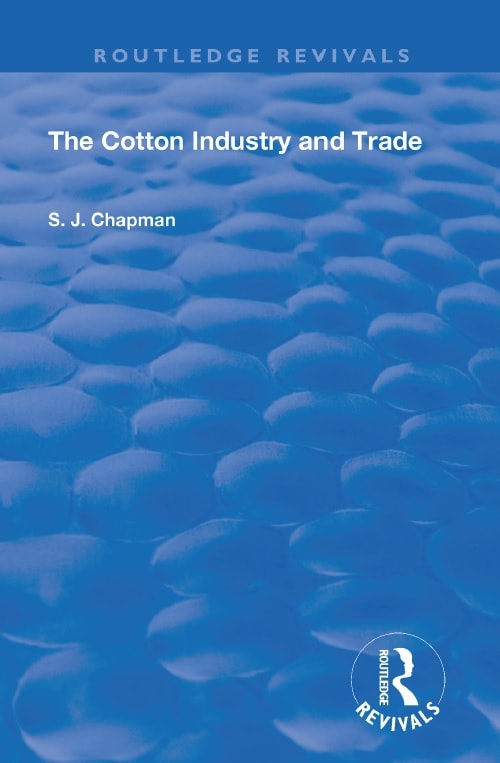By S. J. Chapman

CONTENTS
PAGE
PREFACE VÜ
CHAPTER I
T H E RAW MATERIAL I
CHAPTER II
EARLY HISTORY OF T H E INDUSTRY AND TECHNICAL
ADVANCE 17
CHAPTER III
COMMERCIAL AND INDUSTRIAL ORGANISATION . . . 37
CHAPTER IV
BRITISH TRADE AND FOREIGN TARIFFS . . . . 6 4
CHAPTER V
EUROPE 102
CHAPTER VI
AMERICA AND T H E EAST 138
APPENDIX 168
INDEX 173
LIST OF ILLUSTRATIONS
PAGE
MANCHESTER ROYAL EXCHANGE Frontispiece
From ” The Manchester Gtiardian”
BLOWING ROOM ( C H I N A ) 2 4
From Brooks à? Doxey’s Catalogue
CARD ROOM ( E N G L A N D ) 5 0
From Brooks & Doxey’s Catalogue
S P I N N I N G ROOM (RUSSIA) 7 4
From Brooks or3 Doxey’s Catalogue
DIAGRAM OF Q U A N T I T I E S AND VALUES OF EXPORTS . . . IOO
DOUBLING ROOM ( E N G L A N D ) I 2 Ó
From Brooks &> Doxeys Catalogue
R E E L I N G ROOM ( C H I N A ) I 4 8
From Brooks âf Doxeys Catalogue
S P I N N I N G M I L L , S H A N G H A I , C H I N A . » . . . . j
COTTON M I L L , F I V E S – L I L L E , FRANCE »
From Dobson or1 Barlow’s Catalogue
PREFACE
TH I S work is intended to be an elementary introduction to the economics of the cotton industry and trade. It is, therefore, descriptive to a large extent, but I have attempted here and there to trace causes and effects in a simple way, and introduce the reader briefly to some of the numerous problems that arise out of the subjects treated.
Portions of Chapters II. and III. are elementary statements of matters that will be found more fully treated in my Lancashire Cotton Industry, Authorities for the rest of the work are mentioned in foot-notes, but I ought particularly to mention how considerably my labours were curtailed in the preparation of Chapter V. by the use of Oppel’s Die Baumwolle. Further, I have to express my obligations to the Editor of the Manchester Guardian for permission to reprint parts of two articles that appeared in that paper and to reproduce the illustration of the Manchester Exchange ; to Messrs. Brooks and Doxey and Messrs. Dobson and Barlow for the loan of blocks for illustrations ; and to Messrs. Piatt Brothers for the offer of blocks, which, however, could not be used when the time came for printing, as they were otherwise engaged. My wife has constructed all the tables that are not quoted from other works, and has also read through the proofs.
THE COTTON INDUSTRY AND TRADE
C H A P T E R I
THE RAW MATERIAL
CO T T O N wool is a vegetable down which grows in tropical and sub-tropical climates. Its region may be defined as the areas lying 40o north and south of the Equator. Its requirements in respect of climate and soil could not be discussed with any advantage in this brief sketch, and, as Professor Dunstan has said, the agricultural chemistry of cotton is still in its infancy.1 The cottons known to commerce fall into two great classes, the Oriental and the Occidental, the Indian and the American, but botanically many species have been enumerated. The most important cotton – producing countries at the present time are the United States, India, Egypt, Brazil, and China ; but the last produces almost entirely for home consumption. Indian cottons, which have a very short staple, are grown chiefly at Hingunghât, Oomrawuttee, Broach, Dhollera, and Dharwar. At Dharwar, New Orleans seed has also been successfully raised. In India the cotton plant is reared in regions where long periods of drought are experienced, but the absence of rain for months together in these parts is rendered comparatively harmless by the character of the soil, known as black cotton soil, which is capable of retaining moisture for a long time.
The quantity of cotton produced in America was not large until some time after the Revolution : the cotton used by the colonists was imported from Smyrna and Barbados. Now the quantity of cotton produced in America is enormous, and constitutes by far the most important source of supply.
The increasing proportion sent to other countries than England is noticeable. It is also noticeable that the American crop has not kept pace with the need for cotton: thus, in the years 1870-1, 1880-1, 1890-1, and 1902-3, which may be taken as fairly typical, the world’s consumption of cotton in million bales advanced as follows: 4 9 , 7 2 , 10-3, 1 3 7 ; while the American crop, measured in the same way, moved from 4-4 in the first year to &6y 8-?, and io-8 in the succeeding years mentioned above.
